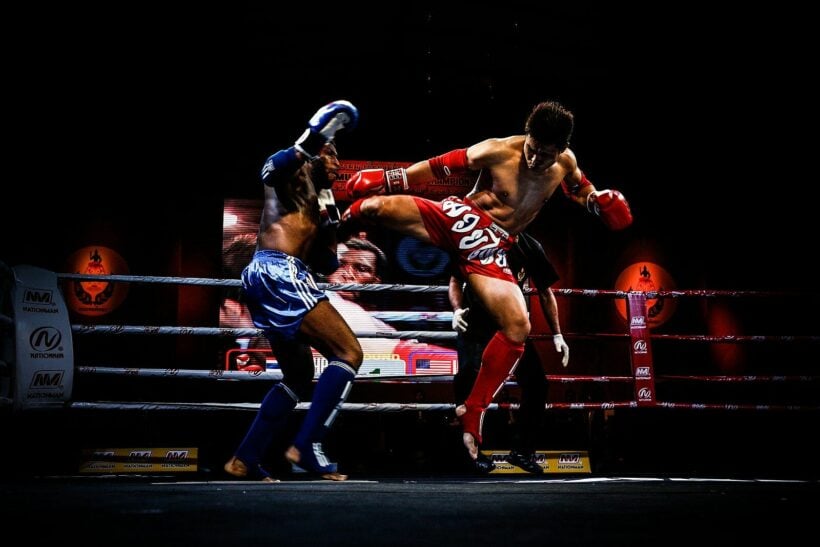All about Muay Thai, Thailand’s national sport

Muay Thai or Thai Boxing is Thailand’s cultural martial art and national sport. The origins of Muay Thai date back hundreds of years ago as modern-day Thai people needed a strong form of close-combat that used the entire body as a weapon to fight off those in neighbouring countries who were constantly trying to invade Siam, the former name of present day Thailand. Although there is much debate among modern scholars as to when Muay Thai was born, there are historical signs that point to as early as the 14th century when Myanmar invaded Thailand’s old capital of Ayudhaya.
Through training and military exercises, Muay Thai techniques were honed, with the goal of each strike to deliver a debilitating blow to the opponent. This hand-to-hand form of combat evolved by being an integral part of the survival of the fittest. Formal muay Thai techniques are divided into two groups: mae mai, or ‘major techniques’, and luk mai, or ‘minor techniques’. Muay Thai is often a fighting art of attrition, where opponents exchange blows with one another.
Muay Thai as a martial art, is referred to as “The Art of Eight Limbs,” as it uses 8 points of contact on the body that take the place of war weapons. For example, the shins and forearms are hardened in training to block against blows, while the hands replaced the sword and dagger. The elbow, which is considered the most dangerous form of attack in the sport as it operates as a hammer. The knees and legs take the place of an axe and staff. The knees and elbows are constantly looking for an opening in the opponent’s body to strike, while trying to knock the enemy on the ground for final blow.
Muay Thai fighters usually start at a young age, as the shelf-life of a fighter is rather short, due to the intensity of each fight. Between 6-8 years of age, they may start training many hours a day, taking on their first real fight between 8 and 10 years of age. Such daily training includes many rounds of about 3-5 periods broken up by a short rest of about 1-2 minutes. The average fighter is said to compete in as many as 120-150 fights during their career, which is about 3 times as many as a boxer. However, after their twenties, many fighters retire and move on to teaching the sport as a way to pass down cultural knowledge and still earn a living wage.
Before formal rules were developed, Muay Thai fighters had no limits as to how many rounds they would fight. The old method of timing a round was to fill a coconut with water, poke a hole in it, and let it sink, signifying the end to a round.
The first formal rules of Muay Thai came after World War II ended. Fights were then divided into 5 rounds with a time limit on each round. A clock instead of a coconut was implemented to time the rounds. And, recently, the sport finally gained the recognition it deserved by becoming officially accepted as an Olympic sport.
The technique of Muay Thai is divided by the type of blows one can deliver. The punching techniques in Muay Thai are used noticeably less than other combat sports in an effort to avoid exposing the attacker’s head to opposing strikes from knees or elbows, as they are the strongest bone in the human body.
Elbows can be used in different directions known as: horizontally, diagonal-upwards, uppercut, downward, backward-spinning, diagonal-downwards and flying. Such terms of delivering attacks by elbows are named: Elbow slash, horizontal elbow, upper cut, elbow forward, reverse horizontal, elbow thrust, spinning elbow, mid-air elbow strike or jump elbow chop, double elbow chop and horizontal elbow.
Elbows are commonly used to deflect a strike from the opponent such as spring knees, side body knees, and body punches or kicks. When used offensively, the elbow strike can be the most dangerous blow to the opponent, causing serious damage or even a full knockout.
Punching, known as Chok in Thai, jabbing, cross, hooks, overhand, back fist, uppercuts and Superman punches are all ways of delivering blows to the opponent by way of hand. Kicking, or Te, in Thai, involves many different techniques. The straight kick, roundhouse kick, diagonal kick, half-knee kick, reverse roundhouse kick, half-shin, kick axe heel kick, jump kick, down roundhouse kick, and step-up kick are all different ways in which to use your legs, shins, and knees to strike the opponent.
The 2 most common kicks are known as the thip in Thai or literally translated as a foot jab. The te chiang in Thai or literally translated to be kicking upwards in a triangular pattern, or roundhouse kick. This type of kick uses a rotational movement, as the name in English describes, and is used by other combat sports. If a roundhouse kick is used by the opponent, a Thai boxer will block the kick with the outside of his lower leg or shin.
Knee, or Ti Khao in Thai, involves a myriad of different techniques just like the rest of the others. Such techniques include: diagonal knee strike, curving knee strike, flying knee strike, or khao loi, in Thai, straight knee strike, or khao thon in Thai, horizontal knee strike, knee bomb, step-up knee strike, and the jumping knee strike.
The foot-thrust, or foot jab, is mainly used as a defensive technique to control distance or block attacks. Foot-thrusts are to be thrown quickly but with enough force to knock an opponent off balance. The straight foot-thrust, reverse foot-thrust, jumping foot-thrust, and slapping foot-thrust are all types of ways to strike an opponent.
There are 6 defensive techniques that help a fighter get out of a bind. Disruption, evasion, avoidance, parries, blocking and anticipation are all types of defenses that are learned when training for the martial art. The idea of a “wall of defense” is used when attempting to block a blow. Shoulders, legs, and arms are used to shield the body from an attack. More advanced Muay Thai blocks are usually in the form of counter-strikes, using the opponent’s weight to intensify the damage upon delivery.
If a fighter is in a clinch, or chap kho, in Thai, the elbows and knees are commonly used as they are, indeed, the body parts that deliver the harshest results. A common way to get out of a clinch is by pushing the opponent’s head backward or elbow them. Muay Thai has other ways to use a clinch including: arm clinch, side clinch, low clinch, and swan-neck. When using a clinch offensively, the fighter’s forearms should press against the opponent’s collar bone while the hands are around the opponent’s head.
So may ask how dangerous is Muay Thai? The answer is that it is considered in the top 10 most dangerous forms of martial arts, according to multiple online rankings, but it is not the most dangerous. Although it emphasizes using the strongest bones in the body, due to the accepted practices of leaving out the head in a fight, amongst other style rules, it doesn’t rank officially as the most dangerous. However, it can be used in a street fight, like all other martial arts, where the dangers can be quite serious.
Beginners looking to learn a martial art can take up Muay Thai at ease, as training focuses on kicking and punching, like most other combat sports. And, like all type of fighting, it depends on the goal of why you are fighting. Self-defense or a knockout blow could make the sport dangerous at different levels. Most of all, many practitioners of Muay Thai insist it is one sport that must be learned in order to be a well-rounded martial artist.
Latest Thailand News
Follow The Thaiger on Google News:


























